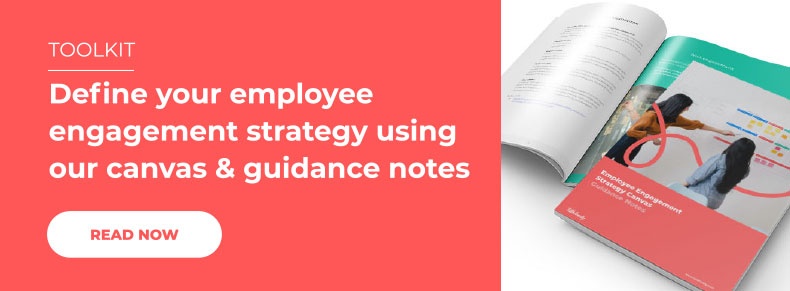What’s the point of an employee engagement survey? A successful survey will give you a deep understanding of what drives engagement in your company. And, it will also highlight any barriers to communication and connection. By finding out what motivates employees to perform at their best and what puts them off, you have some very valuable information at your disposal. It’s the holy grail of employee engagement data. With this information, you have a good shot at keeping employees satisfied and working productively.
With the dramatic changes that have taken place in the working landscape, employee engagement surveys are more crucial than ever. With so many of your staff working remotely, whether long-term or as part of a hybrid working arrangement, it’s not so simple to keep your finger on the pulse of the employee mood. Now, more than ever, you need to know exactly what they are thinking, and how they are feeling.
However, most companies go about collecting this data in the wrong way. The annual employee engagement questionnaire is a standard feature of most organisations. Hundreds of millions are spent on these annual surveys, but the results fail to match the investment. Rarely do you see sweeping changes that have been implemented as a result of the employee engagement questions. Nor do you see marked improvements in productivity and retention. So, what’s going wrong?
In this blog, we take a closer look at employee engagement surveys. Why are they so important? Why is the annual survey missing the mark? And are there better ways to listen to what your employees have to say?
Why the employee engagement survey is important
You need to listen in order to understand. And that means listening to the negatives as well as the positives. Ask the right employee engagement survey questions, and you’ll get the answers you need. They will help you to identify and work on weaknesses in your organisation, as well as help you to improve on strengths and get the most out of opportunities. Employee engagement survey benefits are many and far-reaching.
It gives employees a voice
One of the key benefits of a survey is that it opens up channels for the employee voice. Once you allow your employees to speak and share their concerns and suggestions, you are already improving your engagement levels. The simple act of creating feedback channels will boost engagement significantly. This is particularly relevant for remote and hybrid workers, who can fall out of the loop when they are no longer part of the office environment.
It allows managers to take action
If you don’t know something is wrong, it’s hard to put it right. Employee engagement survey results will highlight when something isn’t working within your organisation. However, beware of the pitfall of listening and not acting. A YouGov poll of 3,000 workers revealed that only 20% of employees believe their managers take action on survey results. Make sure you act on the employee engagement survey questions you ask.
It gives you a sense of direction
The outcome of your survey will give you a roadmap for the journey ahead. From the results, you can build an accurate and personalised employee engagement strategy. Having a clear direction for your business and its employees will impact productivity and morale. It’s one of the strongest drivers of employee engagement. With the world of work changing so rapidly and profoundly, we need a firm rudder to steer us at times like these. An employee engagement survey will provide this direction.
Why are employee engagement survey templates not working?
Listening to your employees is great. In fact, it’s one of the key employee engagement best practices. But how you listen to them is hugely important. And the one-off, large-scale annual task that is the traditional employee engagement survey template is not the best way to go about this. Here, we’ve detailed the main problems with an annual survey:
Timing: They only tell you what’s happening right now
If you wait a year to conduct a survey, you might be hoping that the results will give you a year’s worth of insight. Sadly not. Employee engagement survey results will tell you how an employee is feeling about the past few days and no more. If you want employee engagement statistics that tell you about the past year, you’ll need to take a different approach.
Scope: They try to cover too much ground
Employee engagement survey questions tend to cover every single aspect of company procedure. When you try to cover everything, you end with a vague, unfocused result. What you really want to know is how to engage employees. But instead, you have a lot of data that is unrelated to this essential question.
Effort: They are a chore, not a pleasure, to complete
The approach of an annual employee engagement questionnaire is not usually user-friendly. And once an employee loses interest in answering your questions, the quality of response goes down. It’s important to realise that not every employee will be interested in providing quality feedback. Often, only those who are either very happy or very unhappy put in a serious amount of effort.
Impact: Their success is hard to measure
Without a clear focus, it’s hard to quantify the results. When your questions are vague and wide-ranging, it’s not surprising that they are difficult to interpret. As a result, the outcome of the annual survey on employee engagement is rarely translated into tangible action. One of the critical barriers is the failure to measure and follow up on feedback. Employee engagement theory is built on a fundamental requirement to quantify and measure your input.
Reach: They fail to connect with every employee
Unless you bring together all employees' views and opinions, your picture will be incomplete. It is often the hard-to-reach employees who fail to complete the annual survey, yet it is these people you really need to hear from. So many employee engagement survey examples point to a survey that is only completed by a smaller sub-section of the workforce. With so many remote and hard-to-reach workers, you need to find a route to connect with every single employee.
Five examples of employee engagement surveys that really work
The answer to these issues is to make your feedback requests regular and consistent. Free-flowing feedback channels need to be put in place and utilised frequently. Forget ‘once a year’. Think ‘once a week’ as a minimum. It is the role of internal communications to pick up on the ongoing signals given out by workers. When you’re looking to increase employee engagement with listening skills, this needs to be incorporated into part of the everyday routine.
#1 Pulse Surveys
They’re short, they’re quick, and they’re regular. Fire a pulse survey out to employees regularly – every month, every week – and you’ll gain a flash insight into the company's mood. Pulse surveys will typically focus on one or two questions at most and will be speedy and straightforward to answer. They can cover any of the dimensions of employee engagement, from job roles and working conditions to communication and relationships. Ideal for connecting with time-poor employees and those working remotely, a pulse survey is a fun way to ask for input.
An employee engagement platform will help you put pulse surveys into action. Many platforms will include a Pulse Module, which allows you to monitor the ongoing health of your organisation. You’ll easily be able to send out regular and scheduled check-ups, with a choice of pulse types already built into the system. At-a-glance dashboards and reports let you analyse results instantly.
#2 Poll Questions
Sometimes you just need an answer to a single question. With just one question and multiple answer options, you can get a quick idea of which way the winds are blowing. The beauty of the poll is the ease of answering. Just one click, and you’re done. For this reason, polls have a very high answer rate and are examples of employee engagement surveys that really work.
When you’re trying to drill down into employee engagement initiatives, the poll is invaluable. But how to implement a poll company-wide? Especially when half your workforce is working remotely? This is where the employee engagement app comes into play. With an app, it’s simple to create one-click polls. There are options for anonymous responses to encourage uptake even further. And once you have your answers, the app will pull them together into a quick report that gives you the whole picture.
#3 eNPS Surveys
The Employee Net Promoter Score (eNPS) measures how your employees feel about your company. It’s based on one clear-cut question: “On a scale of 0-10, how likely are you to recommend this company’s products and services to others?” The answers will tell you how many of your employees are ‘promoters’, how many are ‘neutral’ and how many are ‘detractors’.
While eNPS has been criticised for being overly simplistic, it is a useful measure. Used alongside other key metrics, it will give you beneficial insight into levels of employee engagement and motivation. Just asking the question will show employees that you’re listening and care what they think. This should be your starting point if you’re looking for quick and easy employee engagement questions to connect with your workforce.
#4 Suggestion Box
We’re not talking about the old-style manual suggestion box, of course. This is the modern-day online version. It’s about providing your employees with a platform to put forward their suggestions and ideas for improved working conditions. When you ask for ideas, you’ll promote a sense of belonging and the ‘we’re all in it together’ mentality. It’s especially relevant for hybrid and remote workers, creating that vital sense of connection that has been lost in the move out of the office.
An employee engagement platform will help you get a suggestion box off the ground. Look for innovation modules designed to capture ideas and encourage company-wide participation and discussion. And it’s vital to take the next step too. Employees need to see their ideas become a reality. Idea management workflow will help you manage the process, taking forward the great suggestions and putting them into practice. Employee engagement survey examples demonstrate time after time that action is crucial.
#5 Group conversations
Every conversation is an opportunity to listen to how your employees are feeling. It’s easy to forget to ask a simple question such as ‘how are things going?’ when we have targets to meet and projects on deadline. It’s especially true for remote and hybrid workers, who lack the usual opportunities to chat informally. Work engagement levels can slump when employees feel isolated and forgotten.
This is where online group conversations can be a lifeline. The key is to create a social space where employees can chat and share. Employee engagement apps can provide the bridge you need to reconnect with employees. Whether you want to set up dedicated group conversations, or private chats or encourage participation via social tools such as likes and comments, conversation is a simple solution that shouldn’t be overlooked. Sometimes the most straightforward employee engagement ideas are the best.
Employee engagement surveys: the way forward
The employee engagement survey still has its place in the internal communications arsenal, but there are alternative ways to listen to and connect with your employees. When drawing up your employee engagement survey template, remember one key thing; make listening part of the routine.








.jpg)
.jpg)